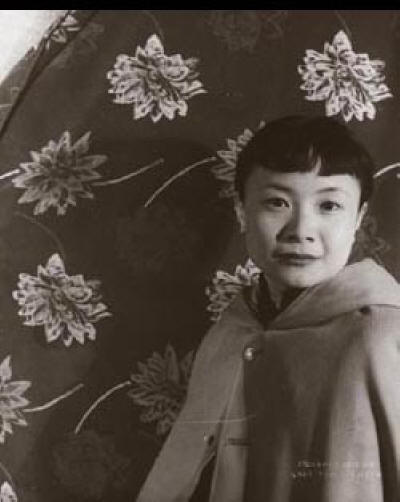

Partner Irene Sharaff, buried together
Queer Places:
Wellesley College (Seven Sisters), 106 Central St, Wellesley, MA 02481
Lucy Cavendish College Library, Cambridge CB3 0BU, UK
116 E 66th St, New York, NY 10065
 Yuen
Tsung Sze (December 2, 1909 – July 16, 1992), known professionally as Mai-mai
Sze, was a Chinese-American painter and writer. The Bollingen Foundation first
published her translation of the Jieziyuan Huazhuan or The Mustard Seed
Garden Manual of Painting with her commentary in 1956.
Yuen
Tsung Sze (December 2, 1909 – July 16, 1992), known professionally as Mai-mai
Sze, was a Chinese-American painter and writer. The Bollingen Foundation first
published her translation of the Jieziyuan Huazhuan or The Mustard Seed
Garden Manual of Painting with her commentary in 1956.
Mai-mai Sze was born Yuen Tsung Sze in Tianjin on December 2, 1909.[1] Mai-mai is a nickname meaning "little sister," [2] and this was the name under which she published all of her books. In 1915 she moved to London with her father Alfred Sao-ke Sze, then the Chinese Ambassador to the Court of St. James's. The family lived there until 1921, when her father Alfred Sao-ke Sze was appointed the first Chinese Ambassador to the United States and settled in Washington D.C. Mai-mai Sze moved there with him and attended the National Cathedral School until 1927, when she enrolled at Wellesley College. At Wellesley, Sze studied the humanities, including English literature and composition, religion, philosophy, European history, and art. She graduated in 1931.[3]
Following her graduation from Wellesley, Mai-mai Sze's primary activity appears to have been painting. She exhibited a landscape in the 1933 Salon d'Automne,[4] and also with Marie Sterner Galleries.[5] Sze also worked as a graphic designer. In a letter to Dorothy Norman, Sze wrote: "I started... as a painter, did a lot of illustrating, ads, designs for packaging, materials, wallpapers...."[6] She illustrated her autobiography, Echo of a Cry.[7] In the same letter to Norman, Sze mentions working also in theater. She made her first and only appearance as an actress in 1936, playing the Honorable Reader in Lady Precious Stream by Hsiung Shih-I.[8]
Sze was notably photographed by several important artists, including Carl Van Vechten, George Platt Lynes, and Dorothy Norman. Some of these photographs were published in fashion magazines including Vogue; it is unclear whether or not modeling was one facet of her career.
116 E 66th St
Lucy Cavendish College, Cambridge
Sze also engaged in political affairs as an active advocate for war relief in China, and as writer and speaker on foreign relations with the Far East. In 1944, she published a pamphlet on China, the second in the International Relations Series published by Western Reserve University Press, at the request of Dorothy Norman.[9] During the Second Sino-Japanese War and throughout World War II, Sze traveled in America lecturing on China and organized the Chinese War Relief Committee in New York. She also published a regular column, "East-West" in the New York Post during this time.[10]
There is little documentation of Sze's relationship with the costume designer Irene Sharaff. The two women were living together at the time of Sze's death in 1992, and they coordinated the donation of their personal collections of books to the New York Society Library together, in 1989.[11] They also made a 1 million pound donation to Lucy Cavendish College, Cambridge "The two ladies first heard about Lucy Cavendish College from an article, which appeared in the New York Times in October 1985 (read the original article). Following this, they met with Dame Anne Warburton, the College President at the time, and donated £1 million to Lucy Cavendish College. As well as funding the Music and Meditation Pavilion, their generous donation also endowed two prestigious research fellowships - the Alice Tong Sze Research Fellowship (named after Mai Mai Sze's mother) and the Lu Gwei Djen Research Fellowship. Sadly neither Mai Mai Sze nor Irene Sharaff were ever able to visit Lucy Cavendish College before their deaths in 1992 and 1993 (they died just a few months apart), but they still asked that their ashes be buried in the gardens of the college. Today, their ashes rest under two halves of the same memorial rock beside the entrance to the Pavilion, surrounded by the music and beauty they so enjoyed". [1].In his history of the Bollingen Foundation, William McGuire wrote that Sze and Sharaff were both students of Natacha Rambova, who held private classes in comparative religion, symbolism, and Theosophy in her New York apartment in the 1930s.[12]
Mai-mai Sze died in New York Hospital on July 16, 1992, at age 82.
My published books: